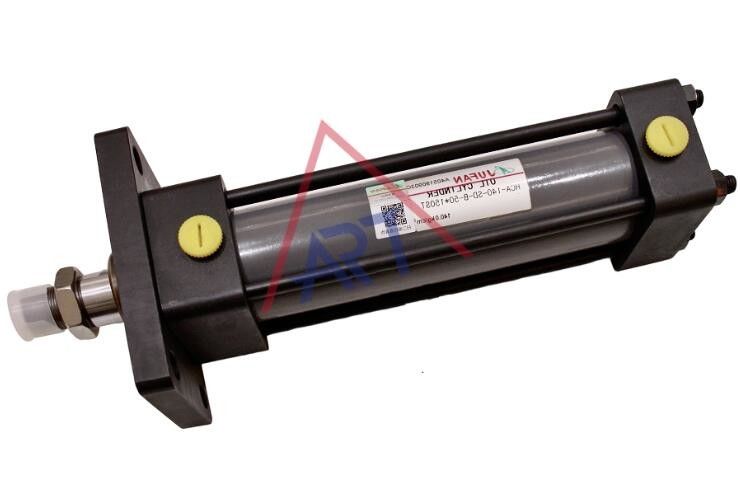Calculation of theoretical output force

Push F1=A1XP1X B
PulI F2=A2XP2X B
A1 : push side pressed area (cm~)A1=nD/4=0.785D
A2 : pull side pressed area (cm~A2=n(Dd)/4=0.785(Dd
D : piston diameter(cm)
d : rod diameter(cm)
P1 : input pressure for pushing forward (kgf/cm~)
P2 : input pressure for pulling backward (kf/cm~) :load ratio
note : 1.the practical out put force of a cylinder is lessthan theoretical force.
2.when a cylinderis moving regularly,load ratiois usully chosen as 0.8,Otherwise 0.6 is used.
example :assume output force is 1000 kgs and workpressure is 70kgf/cmWhat is the suitable bore ofthe cylinder?Ans;
output force F=1000kg
working pressure P=70kgf/cm
load ratioB=08
F,=A,XPXB
A,=F,/(P,X B)=1000/(70X0.8)=17.86cm
A=nD/4=0785D
so..D'=17.86/0.785=22.75cm
D=/22.75=4.8cm=48mm
the suitable bore size is 50mm
Features:
1.Proximity's signal is detected by magnetic sensing between a proximity on the surfaceof a tube and a magnet embeded in piston.
2.The position of proimity's signal is determined by the position of proximity resided on thesurface of the cylinder tube.
3.Proximity can be set and aligned easily that saves time in design and assembly.
4.Extermal dimensions of MGHC inductive cylinders are the same as HC tie-rod cylinders.
Port and ushion positions
| SD type |
LA type |
|

Standard=A:input port B:Cushion position D:Check valve position
|
 |
e.g:order form for position HCA70-LA-C-100X200-B-B-A
Input port=B position
Cushion=A position
Cushion length
 |
Bore(mm) |
L |
l |
| 32--63 |
20 |
10 |
| 80--160 |
25 |
15 |
| 180--224 |
30 |
27 |
| 250 |
35 |
32 |
- Should the movement of a cylinder with loading is above 500mm/sec.,
- If the moving speed is higher than 750mm/sec,external reducing speed valves should be used
The application not only for production mechanical machine tools and metal processing equipment, but also can be widely used in actuators of steel, nuclear power plant control, passenger elevators, etc
| Type |
Symbol |
Drawing |
With Bellow |
Heat Proof |
Bore(mm) |
 |

|
32,40,50,63,80,100,125,150,180,200,224,250 |
| Double acting |
HCA |
 |
HCA-H |
HCA-J |
| Double rod |
HCC |
 |
HCC-H |
HCC-J |
| Double rods with alignment |
HCD |
 |
HCD-H |
HCD-J |
HC2--A--70-- --SD--C--100--200ST-- -- -- -- -- --
1) 2) 3) 4) 5) 6) 7) 8) 9) 10) 11) 12) 13)
| HC2:Tie-Rod Hydraulic Cylinders |
| 1) Type |
A:doubling acting
C:double rods
D:double rods with stroke alignment
|
| 2)Working pressure |
70:70kgf/cm²
140:140kgf/cm²
|
| 3)Performance blank:(standardusage) |
H:with bellow
J:with heat/ erosion proof(the highest temperature is 200℃) |
| 4)Mounting type |
SD/FA/FB/CA/CB/LA/LB/TA/TC |
| 5)Rod size |
C: C class B:B class
note: 1standard:HC-70+C class rod
2.Standard:HC-140+B class rod
3. Please specify when HC-70+B class rod or HC-140+C class rod
|
| 6)Bore(mm) |
32,40,50,63,80,100,125,150,180,200,224,250 |
| 7)Stroke(mm) |
Max.stroke=Max length of stroke-Min. length of stroke |
| 8)Cushion blank: |
no cushion
B:Cushion on bothends
R: Cushion on rod cover
H:Cushion on head cover
|
| 9)Connectors Y |
Y :Yconnector
I:Iconnector
|
| 10)Stroke alignment |
only forward alignment and aligned length < or =stroke length
|
|
11)Port position
|
|
| 12)Cushion position |
|
| 13)Oil seal material blank |
NBR(standard usage),2: PU 3:FPM |
Specifying the needed material while ordering
(1)N:NBR
(2)V:F≤200℃
| Bore |
X |
| 32.40.50 |
1/3.5xstroke+45 |
| 63.80.100 |
1/4xstroke+55 |
| 125.150180.200 |
1/5xstroke+65 |
| 224.250 |
1/6xstroke+80 |
Factory:

Where are hydraulic cylinders used?
Hydraulic cylinders are pretty versatile components. You can find them in various applications across different industries.
They're commonly used in construction equipment like excavators and bulldozers for moving heavy loads. They also play
a crucial role in manufacturing processes, such as in metal stamping machines and plastic molding equipment. You'll even
spot them in everyday things like car brakes and office chairs. So, whether you're building, manufacturing, or just sitting at
your desk, there's a good chance there's a hydraulic cylinder working behind the scenes!
What are the three types of hydraulic cylinders?
There are three main types of hydraulic cylinders, each designed for specific applications and operating conditions:
1. Single-Acting Hydraulic Cylinder
- Operation: In a single-acting cylinder, hydraulic fluid is pressurized on only one side of the piston, typically to extend the piston rod. The return motion is achieved either by an external force, such as gravity or a spring, when the pressure is released.
- Applications: These cylinders are commonly used in applications like jacks, hydraulic presses, and lifting devices where the return force is not as critical or can be provided by external factors.
2. Double-Acting Hydraulic Cylinder
- Operation: A double-acting cylinder has two ports for hydraulic fluid: one for extending the piston rod and another for retracting it. Hydraulic fluid is alternately pressurized on both sides of the piston, allowing for controlled extension and retraction.
- Applications: These are more versatile and are used in a wide range of machinery, including construction equipment (e.g., excavators), industrial machinery, and automotive systems, where precise and consistent movement in both directions is required.
3. Telescopic Hydraulic Cylinder
- Operation: Telescopic cylinders consist of multiple stages or sleeves that extend sequentially. They are typically single-acting, but double-acting versions also exist. These cylinders allow for a much longer stroke than standard cylinders of similar retracted length.
- Applications: Telescopic cylinders are often used in applications where space is limited but a long stroke is needed, such as in dump trucks, cranes, and material handling equipment.
Each type of hydraulic cylinder has its unique advantages, making it suitable for different industrial and mechanical applications.
Hydraulic valves are essential components in hydraulic systems, used to control the flow and direction of hydraulic fluid. Understanding how they work involves knowing the different types of hydraulic valves, their components, and their operating principles. Here's a detailed overview:
Types of Hydraulic Valves
-
Directional Control Valves:
- Control the direction of hydraulic fluid flow within the system.
- Types include:
- Spool Valves: Use a spool to direct fluid flow between different ports.
- Poppet Valves: Use a poppet to open or close flow paths.
-
Pressure Control Valves:
- Regulate the pressure within the hydraulic system.
- Types include:
- Relief Valves: Protect the system from excessive pressure by diverting fluid when the pressure exceeds a set limit.
- Reducing Valves: Maintain a reduced pressure in a part of the system.
- Sequence Valves: Ensure that operations occur in a specific order by maintaining a set pressure before allowing fluid flow to another part of the system.
-
Flow Control Valves:
- Regulate the flow rate of hydraulic fluid to control the speed of actuators.
- Types include:
- Throttle Valves: Manually adjustable orifices.
- Pressure Compensated Valves: Maintain consistent flow regardless of pressure variations.
Components of Hydraulic Valves
-
Body:
- The main housing that contains all the internal components and provides the flow paths for the hydraulic fluid.
-
Spool or Poppet:
- The movable element inside the valve that directs fluid flow. The position of the spool or poppet determines which ports are connected or blocked.
-
Actuator:
- Mechanism that moves the spool or poppet. Actuators can be:
- Manual: Lever or handwheel.
- Solenoid: Electrically operated.
- Hydraulic: Pilot pressure used to move the spool.
- Pneumatic: Air pressure used to move the spool.
-
Springs:
Used to return the spool or poppet to its default position when no actuating force is applied.
-
Ports:
Connections for hydraulic lines. Typically labeled as P (Pressure), T (Tank), A and B (Actuator ports), etc.
Operating Principles
-
Directional Control:
The spool or poppet position within the valve body determines the flow path of the hydraulic fluid.In a typical spool valve, the spool slides back and forth, opening and closing flow paths between ports.In a poppet valve, the poppet moves to open or close the flow path.
-
Pressure Control:
-Pressure control valves use a spring-loaded mechanism to maintain or limit pressure. -In a relief valve, when system pressure exceeds the spring setting, the valve opens to divert fluid and lower the pressure. -In a reducing valve, the valve maintains a lower output pressure by opening to reduce pressure when the output exceeds the set value.
-
Flow Control:
-Flow control valves adjust the size of the flow passage to regulate the flow rate. -In a throttle valve, the orifice size is manually adjusted to control flow -In a pressure-compensated valve, a compensator mechanism adjusts the orifice size to maintain a consistent flow rate despite pressure changes.
Examples of Hydraulic Valve Operation
-
Relief Valve Operation:
-When the system pressure reaches the set point of the relief valve, the valve opens to allow fluid to flow to the tank, preventing excessive pressure buildup.
-
Directional Control Valve Operation:
-In a 4-way, 3-position spool valve, the central position may block all ports, while shifting the spool to one side connects the pump port to one actuator port and the tank port to the other actuator port, controlling the direction of an actuator.
-
Flow Control Valve Operation:
-A needle valve, when adjusted, changes the orifice size, controlling the flow rate to an actuator, thus controlling its speed.
Maintenance and Troubleshooting
-
Regular Inspection:
-Check for leaks, wear, and proper operation. -Inspect seals and replace if necessary.
-
Cleanliness:
-Ensure the hydraulic fluid and components are free from contamination to prevent valve sticking or malfunction.
-
Proper Adjustment:
-Ensure that pressure settings are correctly adjusted according to system requirements. -Regularly check and adjust flow settings to maintain desired actuator speeds.
Hydraulic valves are critical for the precise control of hydraulic systems, and understanding their operation is key to maintaining efficient and reliable hydraulic machinery.
FAQ
Q1: Are you a manufacturer or a trading company?
We have our own factory, so we can provide the best price as well the first service.
Q2: Do you accept customization or Non-standard products?
Yes, we can customize products as the customers required.
Q3: What is your MOQ?
MOQ depends on our clients needs. Besides, we welcome trial order before mass production.
Q4: How long is your delivery time?
Normally, the delivery time is 7 days if we have stock. If we don't have stock, it needs 15-30 working days. And it also depends on the quantity and requirements of products.
Q5: What are your payment terms?
T/T. If you have any questions, please feel free to contact us.

 Your message must be between 20-3,000 characters!
Your message must be between 20-3,000 characters! Please check your E-mail!
Please check your E-mail!  Your message must be between 20-3,000 characters!
Your message must be between 20-3,000 characters! Please check your E-mail!
Please check your E-mail! 

